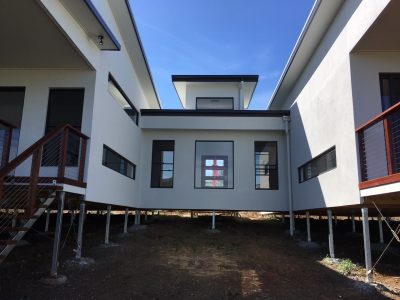
Signs Your House Needs Restumping: Don’t Ignore These Early Indicators
A solid foundation is the bedrock of a stable home, and when signs of compromise begin to emerge, it’s crucial not to turn a blind eye. House Restumping — replacing the stumps that support your house — becomes a necessity when foundation issues arise.
In this guide, we’ll explore common warning signals that indicate your house may need restumping and offer advice on when homeowners should consider this crucial intervention.
Is it Time to Restump My House?
Common Indicators of Foundation Issues
Uneven Floors and Sagging:
When your floors show signs of unevenness, or sag in places, this can be a clear early indicator of foundation issues. To properly investigate, follow these steps:
- Use a Level Tool:
- – Obtain a builder’s level or a laser level.
- – Place the level on various spots on the floor, especially in areas where you’ve noticed unevenness.
- – Check the bubble in the level. It may indicate a problem with the stumps if it consistently shows an uneven surface.
- Measure Floor Height:
- – Using a measuring tape, check the height of the floor in different rooms and locations of the house. Record the measurements as you take them.
- – Compare the measurements to identify any significant variations.
Bouncy or Spongy Floors:
When your floors show signs of bounciness or sponginess, it’s a clear sign that there are foundational issues. This could be dangerous, so it’s important to follow these steps to identify issues:
- Walk the Floors:
- – Walk through your house, paying attention to the feel of the floors beneath your feet.
- – Note any areas that feel excessively bouncy or spongy.
- Listen for Creaks:
- – Listen for creaking sounds as you walk. Creaks may indicate areas with compromised stumps.
- Inspect Floor Coverings:
- – Lift carpets or flooring materials in areas where you sense bounciness.
- – Examine the subfloor for any visible issues such as sagging or gaps.
Sloping Floors – The Marble Test:
Conducting the marble test is a simple DIY method to check for sloping floors:
- Place a Marble:
- – Place a small marble on the floor in different areas of your house.
- – Choose areas where you suspect sloping or unevenness.
- Observe Its Movement:
- – Observe the marble’s movement. If it consistently rolls in one direction, it indicates a slope.
- Measure the Slope:
- – Use a level to measure the degree of slope in the identified area.
- – Significant slope may suggest issues with the stumps supporting that section of the house.
Cracks in Walls, Inside and Out:
If there are cracks in your walls, identifying the nature of the damage is crucial. Here’s how you can do it:
- Examine Crack Patterns:
- – Inspect the walls for cracks, both inside and outside the house.
- – Note the patterns and directions of the cracks.
- – Horizontal cracks may indicate more severe structural issues than vertical cracks.
- Measure Crack Width:
- – Use a ruler or calliper to measure the width of the cracks.
- – Generally, cracks wider than a millimetre could signify potential foundation problems.
Windows and Doors That Stick:
Investigating sticking windows and doors involves a close examination:
- Operate Windows and Doors:
- – Open and close windows and doors throughout the house.
- – Take note of any resistance or difficulty in their operation.
- Check Alignment:
- – Observe the alignment of windows and doors in their frames.
- – Look for gaps or misalignments that may suggest a shift in the house’s structure.
- Inspect Frames and Jambs:
- – Examine the frames and jambs for visible signs of stress or warping; sagging or misaligned stumps can affect the overall alignment of these elements.
Decaying Stumps:
Inspecting stumps for decay involves a visual examination:
- Access Subfloor Space:
- – Enter the subfloor space beneath your house with proper safety precautions.
- – Ensure good lighting for a thorough inspection.
- Check Stump Condition:
- – Examine the condition of each stump.
- – Look for visible signs of decay, such as rotting, termite damage, or fungal growth.
- Probe with a Screwdriver:
- – Gently probe the surface of the stump with a screwdriver.
- – Soft or spongy wood indicates decay and compromises the stump’s structural integrity.
Issues in the Foundation:
Checking for moisture and other issues in the foundation requires a comprehensive approach:
- Inspect Crawl Spaces:
- – Enter crawl spaces with proper protective gear.
- – Look for signs of dampness, standing water, or excessive moisture.
- Check Soil Composition:
- – Examine the soil beneath the house for composition and quality.
- – Pay attention to any shifts in soil or the presence of unusual debris.
- Look for Pest Activity:
- – Check for evidence of pests, including termites or other wood-boring insects.
- – Inspect wooden elements for signs of pest damage.
- Assess Tree Root Presence:
- – Investigate the presence of tree roots near the foundation.
- – Tree roots can exert pressure on stumps and contribute to foundation issues.
- Monitor Settling or Shifting:
- – Regularly monitor for any settling or shifting of the foundation.
- – Note any cracks in the foundation itself.
When Homeowners Should Consider Restumping
If you’re concerned, it’s best to call a professional who is an expert in house stumps as soon as possible to ensure no major damage occurs. These are some considerations to make before making the decision to restump:
- – Severity of Warning Signs: Evaluate the severity of the identified warning signs. If issues are substantial and affecting the structural integrity, immediate restumping may be necessary.
- – Professional Inspection and Assessment: Seek professional inspection and assessment. Qualified professionals can provide accurate diagnoses and recommend appropriate solutions tailored to your home’s unique needs.
- – Regular Maintenance Checks: Include foundation checks as part of your regular maintenance routine. A proactive approach can identify issues early, potentially saving costs and preventing extensive damage.
- – Budget Considerations: Consider the financial aspect of restumping as a worthwhile investment. Promptly addressing foundation issues can lead to cost savings by avoiding more extensive and costly repairs down the line.
Ignoring warning signals of foundation issues can have long-term consequences for your home’s stability. By paying attention to these common indicators and taking proactive steps, such as seeking professional assessments and considering restumping when necessary, you ensure the longevity and structural integrity of your property.
If you’ve noticed any of these warning signals, or if you’re considering restumping, reach out to LevelMaster. Our team is ready to provide referrals to experts who can do professional assessments, quality stumps for sale, and reliable solutions for your home’s foundation.
LevelMaster also supply Steel Stair Stringers with a stair calculator to help you determine the number of treads
Ready to Ensure Your Home’s Foundation is Strong? Contact LevelMaster Today!


